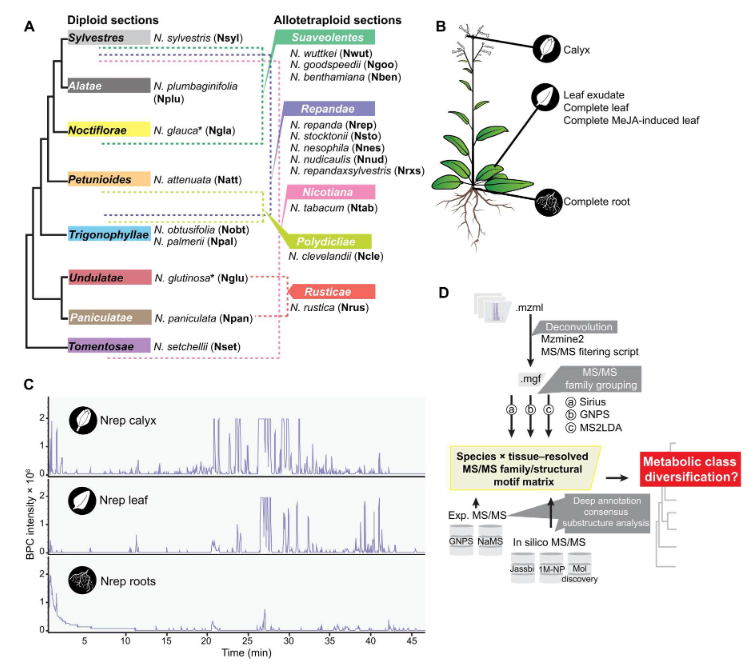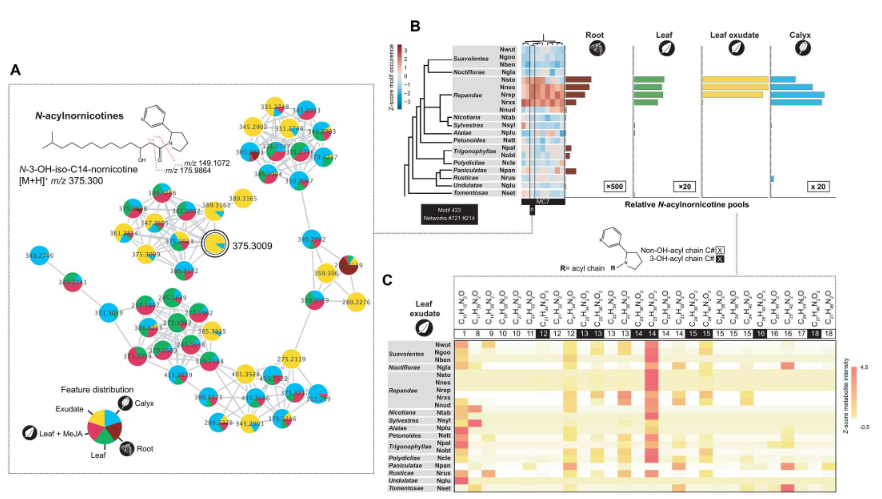On August 25, 2023, Science Advances published online a research paper titled "Evolutionary metabolomics of specialized metabolism diversification in the genus Nicotiana highlights N-acylnornicotine innovations" by Emmanuel Gaquerel's research team at the University of Strasbourg. This study analyzed the diversity of tissue-specific metabolites of more than 20 species in the evolutionary system of Nicotiana genus based on the computational strategies and methods of mass spectrometry metabolomics, and created a chip database containing millions of metabolite structures. A combination of nuclear magnetic resonance and mass spectrometry imaging methods was used to analyze the distribution of N-acylnornicotines (NANNs), an alkaloid specific to the tobacco genus Repandae allopolyploid, and reveal the prevalence of this type of alkaloid in this genus. This study provides an unprecedented classification of specific metabolite diversity and Nicotiana species-specific metabolite types, and provides important resources and research strategies for the study of the evolution of plant-specific metabolites.
Plant metabolites are extremely rich in chemical diversity and functional diversity. The metabolite profile of plants represents a complex trait that reflects the temporally dynamic adaptation and evolutionary characteristics of plants to specific ecological niches. Compared with the broad and conserved central metabolites, specialized metabolites (SM) account for the largest proportion of intra- and inter-species variation in plant metabolic profiles. Nicotiana L. species are ideal for studies of specific metabolite diversity. The genus Nicotiana consists of 13 evolutionarily complete sections, including at least more than 80 species, with extremely diverse forms, ranging from herbs and shrubs to small woody species. Among the specific metabolites of Nicotiana genus, NANNs are thought to arise from a recent allopolyploidy event, which results from the N-acylation of pronicotinoids with long fatty acyl chains.
In this study, in order to comprehensively analyze the diversity of specific metabolites at the tissue level of Nicotiana genus, the authors selected 20 species containing major sections in tobacco evolution and analyzed the metabolites of their leaves, roots and calyces.

A total of 17,901 non-redundant metabolites were identified using the UPLC-ESI-QTOF MS method. Comparing the diversity characteristic patterns of different species, according to α-diversity values, the diversity of specific metabolites was highest in leaves, followed by calyces, and lowest in roots. The authors then calculated interspecific metabolic distances based on molecular network information and used this information to construct a phylogeny metabolomics tree.
Next, the authors identified and classified the specific metabolites of each species. First, the CANOPUS tool is used to predict systematic compound categories and chemical ontology. Then, FBMN and CANOPUS information are combined to complete NP-CANOPUS prediction of frequency-based molecular networks. Finally, metabolites are classified and mapped to each species.
The authors used the data of 1 million mass spectrometry chips and corresponding substructure data obtained in this study to conduct in-depth annotation of metabolites. A unique combination of different computational methods was used to generate a multimodal profile of specific metabolites, which can identify their molecular networks from CANOPUS-based ontology predictions and connect them to given categories, further identifying predicted common substructures in these networks.
The authors then analyzed the unique chemical substructures of specific metabolites of each species of Nicotiana genus. The nonmetric multidimensional scaling (NMDS) method is used to infer the statistical association between species and specific CANOPUS superclasses or the most specific class predictions, and hierarchical clustering is performed on the extracted most significant association groups to obtain four main categories called family clusters (FCs). Among them, FC4 is mainly highly related to the substructure of phenylpropanoid derivatives and alkaloids, and the latter further highlights the richness of alkaloid metabolism in the Repandae section.
NANNs is considered to be a specific metabolite in the leaves of the allopolyploid species of the section Repandae. In this study, the authors analyzed the structural diversity of NANNs and found 102 annotated NANNs which was far more than previously reported structures. In addition, it was unexpectedly found that the roots of Nicotiana species also have NANNs diversity, although their number is nearly 2 orders of magnitude lower than that of leaves, and they have large chemical differences.

Finally, the authors evaluated and analyzed the diversity of NANNs in Nicotiana species. Based on the results of the all tissues-level ancestral state reconstruction analysis of the matK species tree, the simplest explanation for the evolution of the NANNs pathway is that it precedes the formation of the Repandae section.
In summary, this study based on the computational strategy and algorithm analysis of mass spectrometry metabolomics provides open data and rich resources for the study of specific metabolites in phylogenetic species of Nicotiana genus. At the same time, the method established in this study has important reference value and guiding significance for evolutionary metabolomics research on other species and future evolutionary biochemistry research.
Reference:
Elser, D., Pflieger, D., Villette, C. et al. Evolutionary metabolomics of specialized metabolism diversification in the genus Nicotiana highlights N-acylnornicotine innovations. Sci Adv. 2023, 9(34): eade8984.